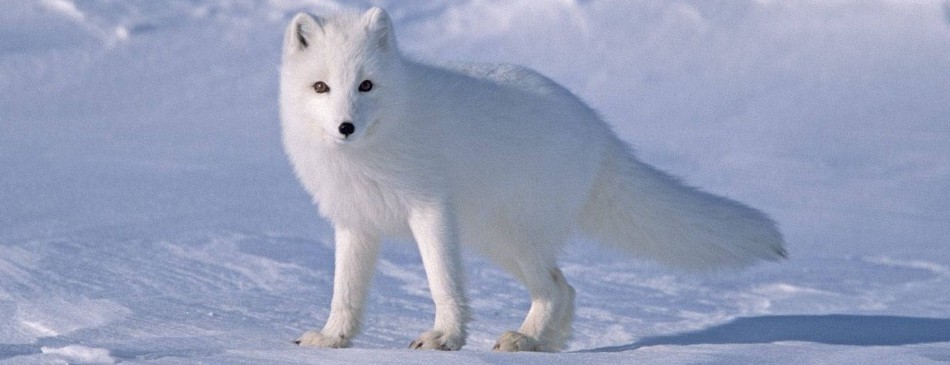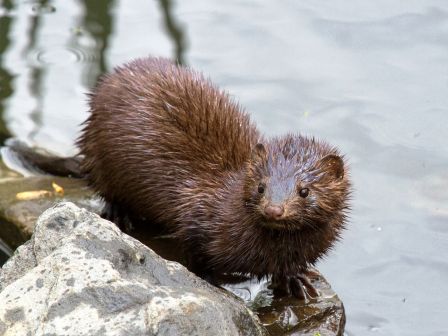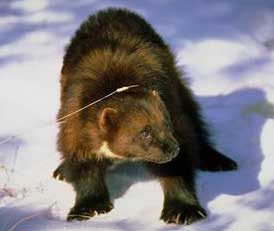Alaska has eight members of the Mustelidae weasel family including the wolverine, fisher, river otter, sea otter, marten, short tailed weasel, least weasel, and the mink.
Wolverines are found primarily in the more remote areas of mainland Alaska and on some islands in Southeast Alaska. Wolverines are better adapted for scavenging than for hunting and are opportunistic eaters. On rare occasions, wolverines may kill moose or caribou
Marten are found from Southeast Alaska to the start of treeless tundra in Alaska's north and west. Marten are abundant in Alaska, being most common in the bogs and black spruce forests of Interior Alaska. In much of their range, especially in less optimal habitat, meadow voles and red-backed voles are marten's primary food source.
Mink are found in every region of Alaska except Kodiak Island, the Aleutian Islands, Bering Sea offshore islands, and most of the North Slope. Mink are opportunistic hunters, eating almost anything that they can kill; important food sources include fish, birds, bird eggs, insects, crabs, clams, and small mammals. Wolves, foxes, hawks, owls, lynx, and river otters occasionally prey on mink, but the effects of predation on mink population have been studied relatively little. In Alaska, Mink are sometimes trapped for their fur.
The river otter (Lutra canadensis) is a long, elongated water-loving animal. They are especially abundant throughout Canada. Otters inhabit rivers, streams, lakes, ponds, marshes and inland waterways. These social animals may make their home in a hollow log or abandoned beaver lodge; however, they usually dig a hole into the bank of a stream or lake.
Mustelidae, commonly referred to as the weasel family, are a family of carnivorous mammals. general are phylogenetically relatively primitive and so were difficult to classify until genetic evidence started to become available. The increasing availability of such evidence may well result in some members of the family being moved to their own separate families, as has already happened with the skunks, previously considered to be members of the mustelid family.
Mustelids vary greatly in size and behavior. The least weasel is not much larger than a mouse. At the other end of the scale, giant otter can measure up to 7.9 feet in total length and sea otters can exceed 100 pounds. The wolverine can crush bones as thick as the femur of a moose to get at the marrow, and has been seen attempting to drive bears away from its kill. The sea otter uses rocks to break open shellfish to eat. The marten is largely arboreal, while the badger digs extensive networks of tunnels, called setts.
Some mustelids have been domesticated. The ferret and the tayra are kept as pets (although the tayra requires a Dangerous Wild Animals
license in the UK), or as working animals for hunting or vermin control. Others have been important in the fur trade. The mink is often raised for its fur. As well as one of the most species-rich families in the order Carnivora, mustelidae is one of the oldest. Mustelid-like forms first appeared about 40 million years ago, roughly coinciding with the appearance of rodents. The direct ancestors of the modern mustelids first appeared about 15 million years ago.
Within a large range of variation, the mustelids exhibit some common characteristics. They are typically small animals with short legs, short round ears, and thick fur. Most mustelids are solitary, nocturnal animals, and are active year-round. Mustelids, with the exception of the sea otter, have anal scent glands that produce a strong-smelling secretion the animals use for sexual signaling and for marking territory.
Most mustelid reproduction involves embryonic diapause. The embryo does not immediately implant in the uterus, but remains dormant for a period of time. No development takes place as long as the embryo remains unattached to the uterine lining. As a result, the normal gestation period is extended, sometimes up to a year. This allows the young to be born under more favorable environmental conditions. Reproduction has a large energy cost and it is to a female's benefit to have available food and mild weather. The young are more likely to survive if birth occurs after previous offspring have been weaned.
Mustelids are predominantly carnivorous, although some will sometimes eat vegetable matter. While not all mustelids share an identical dentition, they all possess teeth adapted for eating flesh, including the presence of shearing carnassials.
|
|








